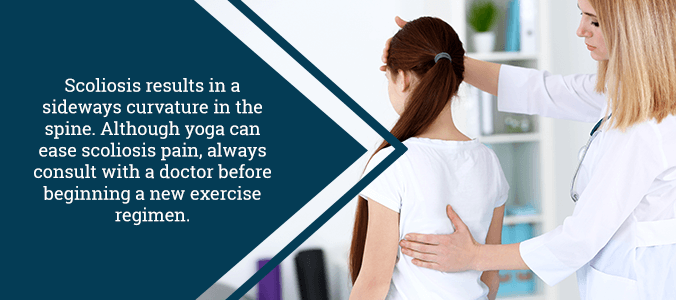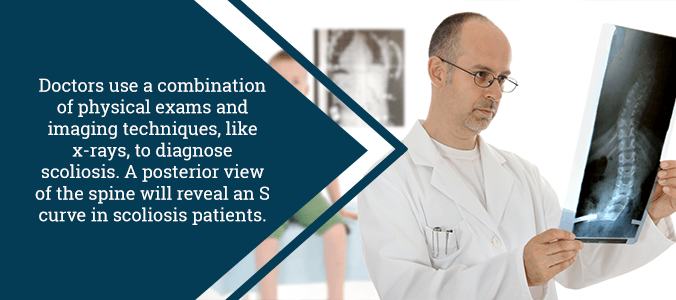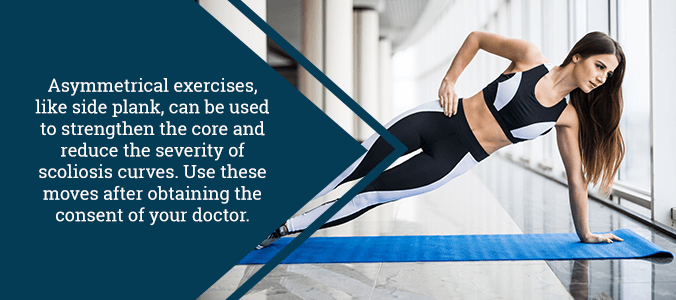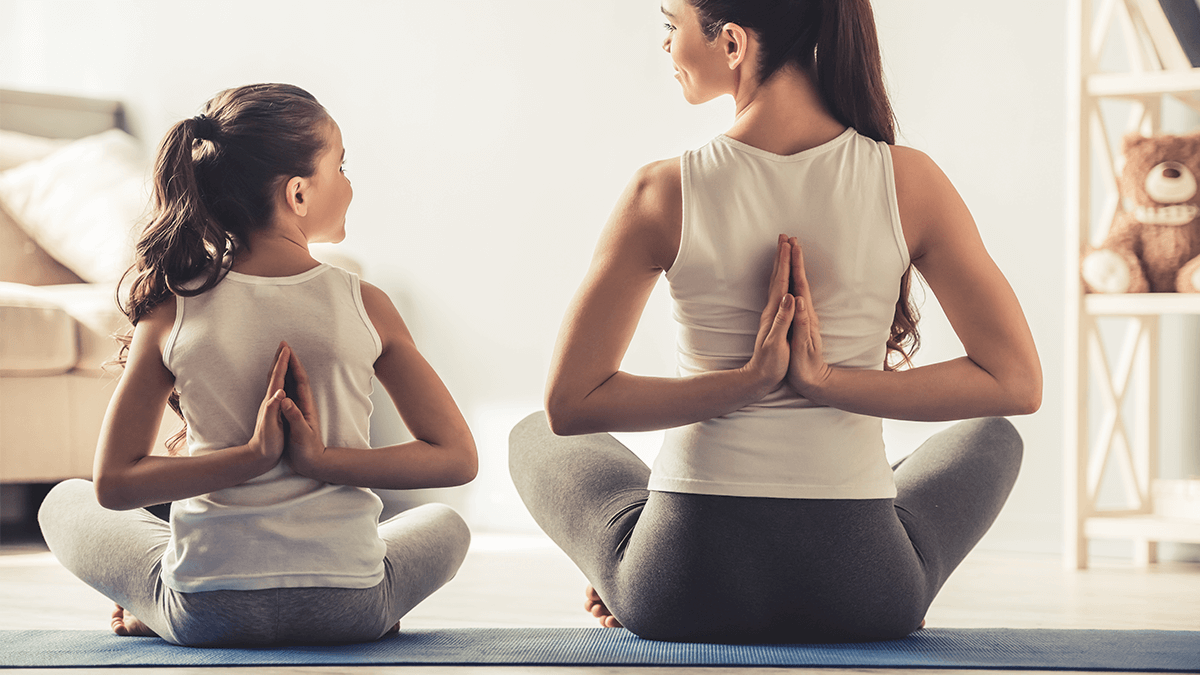Practicing Yoga & Pilates with Scoliosis
Have you or your child recently been diagnosed with scoliosis? If so, then you’ve probably heard about several treatment options. What if you want to take an active role in reducing your scoliosis pain and improving your posture?
There are, in fact, some things you can do to manage your scoliosis. A yoga or pilates routine can be a great way to take better control of your condition. But how does it actually work?
Use this guide to achieve a better understanding of scoliosis and how exercise can empower you to address your condition.

What is Scoliosis?
Understanding scoliosis starts with getting to know your spine. As you probably know, your spine is a column of bones, known as vertebrae, that extends from the base of your skull to the pelvis. Contrary to what some believe, the spine is not straight. A normal spine has forward and backward curves that help to distribute stress as you go about your normal activities.
Some spinal curves, however, are not normal. A sideways curvature of the spine (to the left or right) is known as scoliosis. Those with scoliosis have a “C” or “S” shaped bend in the spine when viewed from the back of the body. This curve is actually a complex condition that involves the rotation of the vertebrae. As a result, one may experience pain because of muscle asymmetry in the back and resultant nerve compression.
In many cases, these curves develop in the thoracic spine (i.e. the chest and upper back area). This condition can affect children, adolescents, and even adults.
Those with mild scoliosis may not show any symptoms. However, more severe cases can lead a person to experience:
- Changes in posture
- Pain while standing or walking
- Muscle spasms in the back
- Back pain and inflammation
- Reduced range of motion
- Uneven waist or hips
- Different leg heights
- Changes in gait
- Difficulty breathing
In addition to physical symptoms, you may experience psychological effects as a result of limited mobility, noticeable deformities, and struggles with pain.
Types of Scoliosis
Scoliosis is a blanket term for a sideways curvature of the spine. Let’s take a closer look at the two most common types of scoliosis.
- Idiopathic scoliosis. This is the most common form of pediatric scoliosis. It usually begins during childhood or adolescent growth spurts. Although the exact cause of idiopathic scoliosis is unknown, many believe genetics plays a role.
- Adult or Degenerative Scoliosis. Some individuals over the age of 50 may start to develop scoliosis. As we age, everyday wear and tear causes the spine to naturally degenerate. Gradual damage to the facet joints and intervertebral discs may cause spinal asymmetry, thus resulting in scoliosis. Spinal cord injuries, osteoporosis, and degenerative disc disease commonly precipitate adult cases of scoliosis.
Identifying and Diagnosing Scoliosis
Routine doctor visits and school screenings can allow for detection of scoliosis in children. For those with adult scoliosis, the doctor will take into account your symptoms, lifestyle, and family history. Then, during a thorough physical exam, the doctor will assess the patient’s flexibility, strength, and reflexes. If scoliosis is suspected, then the doctor may order diagnostic imaging such as an X-ray, MRI, or a CT scan to view the spine and measure the sideways curvature.
The curvature can be identified in two ways:
- Levoscoliosis: An abnormal curvature to the left. This usually occurs in the lumbar areas of the spine. When it affects the thoracic spine, or chest, region, it can compress the organs and lead to problems with the heart and lungs.
- Dextroscoliosis: This occurs when the spine curves to the right. This type of scoliosis usually affects the thoracic spine region and is common in children and adolescents.
In addition to the curve, those with structural scoliosis usually have a rotation or spiral to the spine. The body compensates for these structural problems by developing a convex and concave side of the spine. The concave side has shortened muscles that become denser and less flexible. In contrast, the convex side has lengthened muscles that are weakened from being overstretched.
Once you are diagnosed with scoliosis, your doctor will provide you with several treatment options. Certain physical exercises and even the guidance of a physical therapist may be suggested. At this point, you may want to ask your doctor if yoga or pilates may be a good option.

What is Yoga and Pilates?
You’ve probably heard these terms before. If you aren’t a regular gym goer or fitness enthusiast, then you may not know what they mean. Yoga and pilates are two different types of exercise routines. They do, however, boast some of the same benefits for your overall health and wellness—especially if you suffer from scoliosis. Let’s take a closer look.
Yoga
Yoga is a term for several physical, mental, and spiritual practices that originated in India over three thousand years ago. In Western culture, we often associate yoga with Hatha Yoga practices. This physical aspect of yoga uses breathwork and certain poses to increase flexibility, strengthen muscles and connective tissues, and align the vertebrae. In addition, it helps stimulate several body systems and even has positive effects on the brain.
Pilates
Pilates is an exercise routine that focuses on the core muscles and helps to address muscular imbalances, posture, balance, and flexibility. Workouts are generally performed on an exercise mat with low-impact muscular strength and endurance movements.
Both routines can be adapted to just about any fitness level. As you become familiar with the poses or exercises, you can challenge yourself even more and witness better results.
How Can Yoga and Pilates Help with Scoliosis?
You’re probably wondering how all this stretching and breathing can help with your scoliosis. You may actually be surprised.
Let’s look at one example. In a small study conducted to investigate the effects of asymmetrical strengthening, 25 participants with idiopathic scoliosis performed a common yoga pose for a short period of time, nearly every day for 6 months. This pose, the side plank, involves the person starting on their side with their feet together and one forearm directly below the shoulder. The person then raises his or her hips and contracts the core muscles. Holding the body in a straight line from head to feet, the person takes deep breaths for up to a minute or more.
The results of the study showed up to a 40% reduction of curvature for 19 of the participants. Of course, each person’s scoliosis is different. What may work for one person may not be effective for others.

While these exercises and poses typically don’t cure your scoliosis, yoga and pilates do offer many health benefits, including:
- Improved posture. Yoga and pilates help with strength and flexibility that can improve posture. In addition, regular practice can allow you to develop a mind-body connection where you become more aware of your posture in everyday activities.
- Increased respiratory capacity. A major aspect of yoga and pilates is focusing on the breath. Participants often hold poses or perform exercises while breathing at specific times. The deep breathing exercises can improve a person’s lung capacity.
- Deeper relaxation. When you are stressed out or anxious, your muscles often tighten. Since scoliosis affects the muscles in the back and core, the more relaxed you are the less contracted the muscles may be. This can assist greatly with pain management.
Before you run off to your local gym or yoga studio, you want to receive clearance to exercise from your doctor. In addition, you may want to discuss these routines with a physical therapist or chiropractor, since they have much more experience with scoliosis than an instructor at a gym. You don’t want to make your condition worse by performing exercises that may actually increase pain or potentially cause more damage.
Many People with Scoliosis Require a Doctor’s Care
Some people with mild forms of scoliosis may not even know they have it. Those dealing with the symptoms mentioned earlier, should consult with a scoliosis doctor. While yoga and pilates can be helpful, it is usually used as a complementary practice. Other treatments are often necessary.
In fact, scoliosis surgery may be the best option for some. For example, a spinal fusion will help to stabilize the area and stop curve progression. Thanks to technological advances, some of these surgeries are minimally invasive. Using tiny cameras and surgical tools, doctors only need to make a couple of small incisions to treat the area. As a result, you can expect less pain, damage to the body, and quicker recovery times.
Is scoliosis affecting your health and quality of life? You want to make sure you work with an experienced doctor who knows how to treat this condition. Dr. Jason E. Lowenstein is a leading expert in the field of scoliosis and spinal deformity care. His dedicated, compassionate work has earned him several awards including Inside Jersey Magazine’s “Top Doctor” and New Jersey Family Magazine’s “Favorite Kids Doc.”
Are you ready to get your scoliosis under control? A simple call to (855) 220-5966 gets you in touch with an industry-leading expert in scoliosis care. Schedule a consultation today to see how Dr. Lowenstein can help you.
